
Recently, Google introduced search with generative AI. This exciting announcement sent shockwaves through the SEO industry and shook several business categories to their core.
I spent the last week researching the changes and analyzing how those changes could impact various industries. I also blended that information with existing trends we see in Google to put together ideas you can use to get ahead of the wave of this transformation in how we search and how your business survives online.
But before we dive in, let’s get the formal stuff out of the way first.
I don’t work at Google, nor do I know their “secret sauce.”
I am not on their product development team, so all of my thoughts about current patterns in Google and takeaways from public videos and responses I have read online.
The new look of Google Search results
Before we talk about why Google is making this shift in search results, I think it’s important to discuss some of the new features we expect Google to implement.
In one of their promotional videos, Google shows searches and their corresponding results in the Google search results.
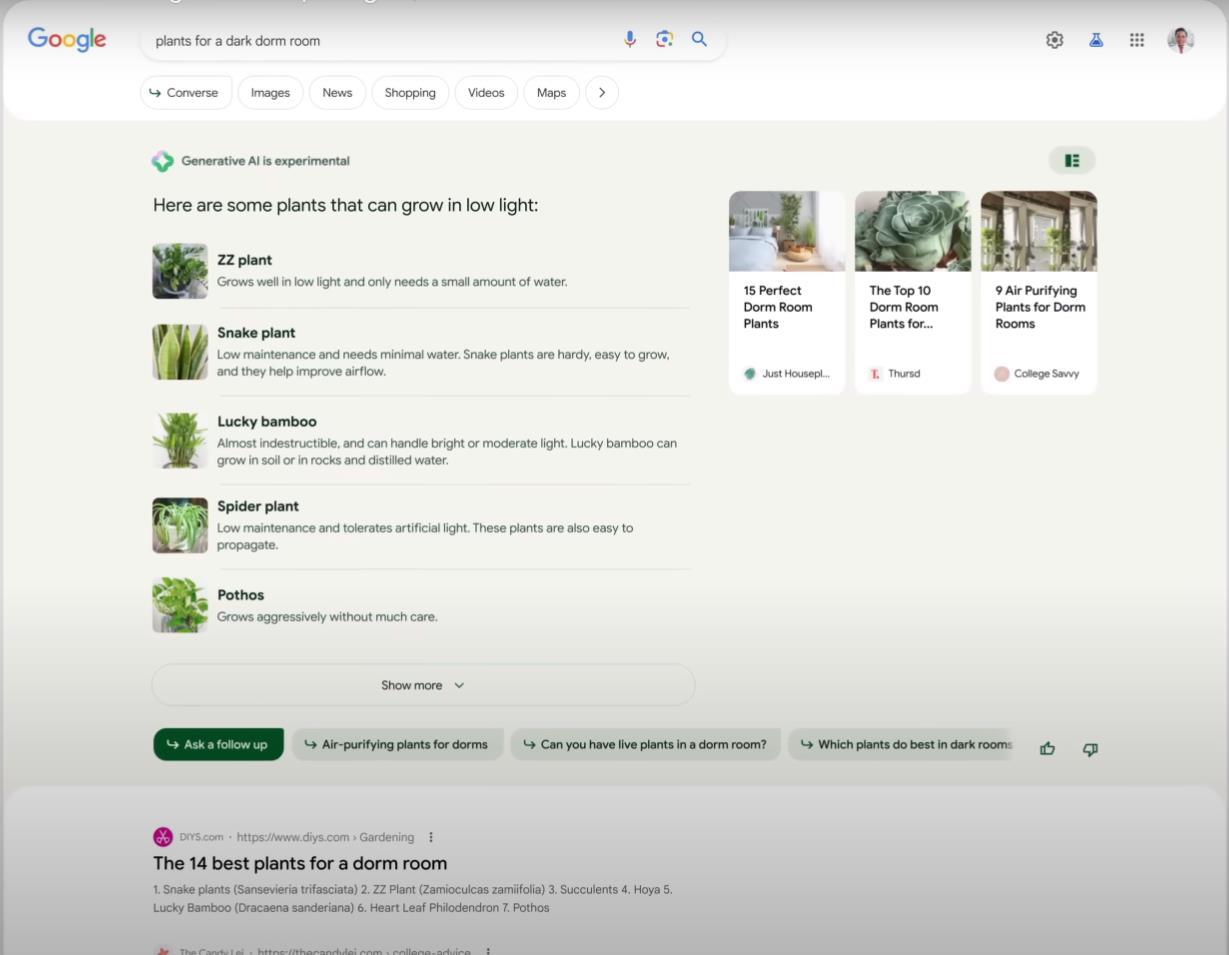
In this screenshot, we can see some interesting points that are important to take note of.
- Google prioritizes the AI results at the top of the screen and then places organic listings at the bottom of the page. The top part of the page is called Google Search Generative Experience (SGE).
- Near the top of the results, Google places “cards” with companies that have educational content about the search query. It looks like some of the results in the organic section are the same as those listed in the card section.
- Above-the-fold content is focused on educational content for informational intent. This is important to note because your SEO strategy will vary based on the intent of your searchers.
- I imagine that specific search queries and results will show paid ads, local listings, shopping ads, and hotel ads in the top area of SERPs.
Of course, these observations are made from a single video and only take into account a few of the use cases Google provides.
However, I think it is important to glean as much information as we can about the technology that Google intends to use and how its results will show so you can adjust your marketing strategy accordingly.
It’s not a perfect solution, but it’s important to keep thinking about these factors as we look at how Google Search is changing.
How Google Search is changing
Google’s business model is to get as many people to use their search engine as possible.
This will lead to more people seeing and clicking on Google Ads, which is how Google makes money.
It’s important to understand this point so we can frame everything we talk about in coming changes around the fact that Google wants to find the balance between maximizing revenue generation (position paid ads) with the understanding that people won’t go to Google if there are only paid ads.
This means there will be a balance between the placement and positioning of paid advertising and when and where organic results appear.
Google also says that they are integrating generative AI because with this technology, they can
“… unlock entirely new types of questions you never thought Search could answer, and transform the way information is organized, to help you sort through and make sense of what’s out there.” – https://blog.google/products/search/generative-ai-search/
This tells us that Google will remain focused on answering questions and organizing information in a specific way that is optimized for quick information retrieval by the user.
We can see this in the promotion video that outlines how generative search will work in the future.
The presentation and video show that Google is updating how they present information in the search engine results page (SERPs). Instead of relying on the traditional 10 blue links, Google is making the process of using a search engine to be focused on visual content from various sources around the web.
It’s important to note these general observations because all of our forecasts for what will change and how your business can adapt to those changes will be based on Google’s financials while also balancing the fact that publishers provide Google with information to display in search results.
No publishers mean Google doesn’t have a business model.
But what does that mean about the future of Google’s search engine? Well, I think it’s important to think about the answer from Google’s point of view.
A shift in Google’s business model
As a business owner, you know how important it is to get your business listed in SERPs for a specific search query. Traditional search engine optimization (SEO) wisdom has always been to write comprehensive content on a topic to show you are an expert in the field.
Over the years, in general, I have found that Google rewards companies that write long-form content that dives into a given topic. These blog posts went to nuanced details about the subject and provided a wide scope of information about the topic.
The idea has always been to cover as many aspects as you can (within reason) on a subject in a single blog post to improve your ability to rank in Google.
I think this trend is going to change drastically in the future.
Sure, Google will still have organic listings in SERPs, but those listings will be pushed down off of the screen. These links will be used by people who need to do additional research, but I believe (as Google likely does) that the majority of people will utilize the generative AI results that are pushed at the top of SERPs.
It’s essential to consider this as we continue to think through what changes in Google search will take place and how your business will need to adapt.
Why Google is making this shift
As discussed in the previous section, modern SEO has relied on long-form, educational content that covers a topic in depth. This usually resulted in longer blog posts, and Google traditionally rewarded companies that talked about topics in depth by placing that content near the top of search results.
I think this model will change for a few reasons.
First, Google knows that AI content generation programs like Jasper.ai and ChatGPT are not going anywhere. These tools make it easy for any company to write long blog posts about any topic, which means companies are incentivized to go after every keyword under the sun that applies to their business.
Google needs to adjust how the places content because the new way of making content will overburden its current business model and capabilities if not accounted for.
Second, we can see in the screenshot below that Google is prioritizing snackable content to help searchers understand a topic from a general perspective.
While this is only one example of what the final search results page may look like, and the search query shows informational intent, I think we can make some general assumptions in how the process will work.
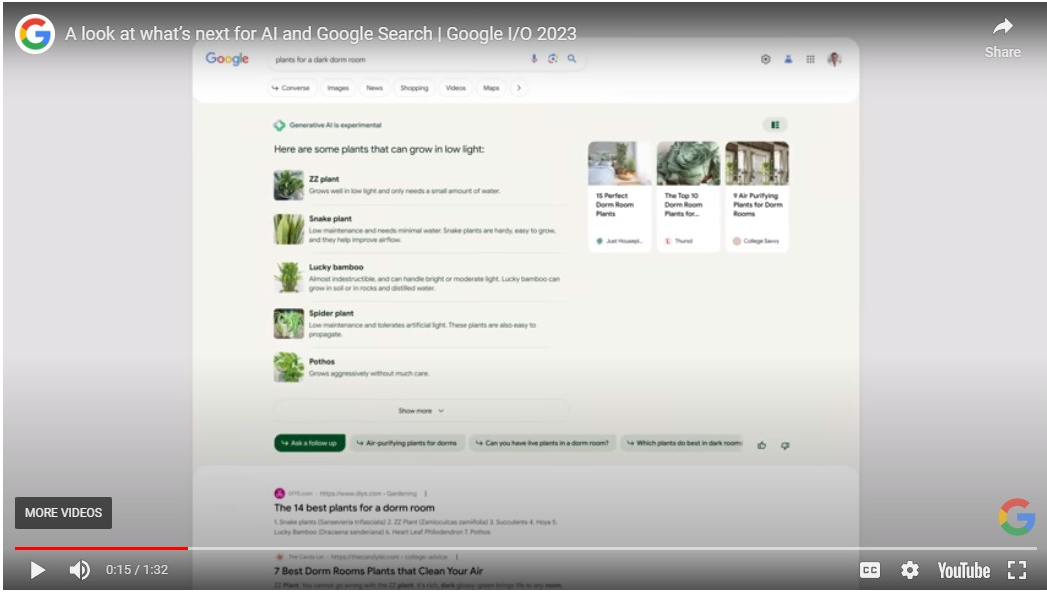
Here are some points I take away from this example and how you can apply it to your business marketing strategy:
- Understand the search intent of your users. It’s going to be essential that you nail down who you are trying to reach, the problems you want to solve, and what their intent is when searching on Google. Different search intent may (likely will) drastically alter the information that is shown and how that information is displayed on Google.
- Focus on educational content. Several examples of search results showed lots of educational content. This makes sense, as Google wants to prioritize their paid ads (as we discussed earlier) over pushing people to affiliate sites or other websites that make money. Google wants to get its cut.
- Generative AI will result in long tail keywords because people will look for specific problems and let Google aggregate content from around the web.
- Your content needs to be snackable. This means your blog posts need to be formatted with different elements like bullet point lists to make it easier for people and search engines to find and digest the content on your website.
- I think Google will start to push podcasts and news stories from it’s own platforms. It’s already pretty well known that Google can chop up and archive podcasts to help listeners find relevant information quickly. I think Google will start to push these snippets of podcast episodes to fill up the generative search results section, so you should start pushing more podcast content if your users need education about your products or services before buying.
As you can see, the new wave of Google search will require a comprehensive strategy that includes lots of content types.
Simply put, a general “throw it at the wall and see what sticks” approach to content strategy will suffice any longer.
I have seen several examples already with some internal tests where Google’s results differ greatly between small differences in the search queries I use to search for information.
A shift in your keyword research
Most companies and SEOs focus on keywords that have high search volume. These types fo keywords are called “head” keywords because they are general, very generic keywords that cover a variety of topics and searches.
Long-tail keywords, which are keywords with lower search volume but more specificity from the user’s intent, are usually overlooked by SEO companies and business owners because they don’t represent a wide-net approach.
I think the shift towards extremely long-tail keywords will be made with generative AI and the future of Google Search.
I found an example in the video I shared earlier where Google showcased an example where multiple questions were combined into one search query. Instead do dress for an outdoor wedding, the example showed an extremely specific search for “dress for an outdoor wedding in Miami in May in a trending color 2-day delivery”.
This search is interesting for a few reasons, and this is what I think we can take away from this example and how your business can position itself:
- Users can mix intent in searches moving forward. The above example shows informational intent (“dress for outdoor wedding”) and transactional intent (“2-day shipping”). If you sell clothing, you will need to include as much information about your dresses as possible on the product pages.
- The shift will be extreme user intent. Every piece of content you publish from YouTube videos to blog posts, will need to be focused on the user. You won’t be able to just talk about outdoor wedding dresses, but you will need to format your content to provide lots of snackable components in the larger piece of content. This will be tricky, and it will vary by industry, but I think it is doable with the right strategy.
- You will need to run shopping ads if you have an online store. This is not SEO-related, but I think it’s important to reiterate that Google is pushing everything it can to monetize search results.
Keyword research is, and will continue to be, a central part of SEO. However, how your business thinks about keywords and content will need to change based on your industry and how Google changes search for keywords with specific user intent.
A shift in content strategy
There are two general areas of content in SEO, on-page and off-page content. On-page content is exactly what it sounds like- it is content that you publish on your website and this is usually referred to as different types of content marketing. Google uses things like blog posts, images, and pages on your site to understand your business and rank you in search results.
Off-page content is a larger set of content that includes everything from YouTube videos, Facebook posts, and other forms of content that talk about your business.
Let’s look at how a new feature Google announced called perspectives on Search could impact your content strategy and how you can prepare for it. Here is a quick screenshot of what perspective on Search is, so we can reference the same tool as we discuss a shift in content strategy with Google’s new search features.
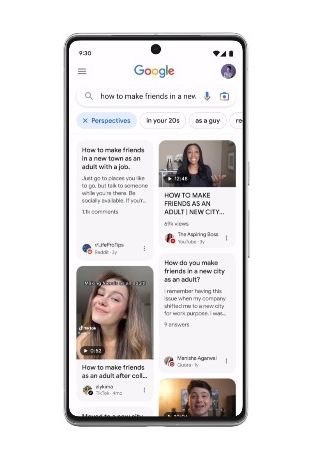
The purpose of this product is to help users explore diverse perspectives and gain a wider understanding of a topic. How this feature will apply to your business will vary, but I have a strong feeling that it will have a significant impact on travel and hospitality.
A shift in on-page content
On-page content, as we discussed above, is content that you publish on your site. This content will continue to carry a lot of weight, as Google will continue to include a list of websites below the generative AI section of SERPs.
I think where on-page content will change is the length, depth, and breadth of the content itself. I think Google will change how it rewards content and what it deems “good content” when ranking.
This shift is to promote content that can be used in perspectives of Search, and balance with the traditional display of links in SERPs.
Here are some observations, expectations, and what your business can do to prepare for the adjustment.
- Rethink how you define what a “good blog post is.” In the past most SEOs and business owners thought a good blog post was a 2,000-word post that covered a topic in depth. This may still be the case for your business is in B2B or other industry that has a long sales cycle.
- Make your blog posts digestible. You will need to break up your blog posts in different sections, and use bullet points and other tools to make the content easier for your audience to read. You will also need to make the content easy for Google to parse.
- The future of blog writing will not be the depth or even the breadth of your topic, but how easy it is for robots to parse the content and display in the AI generated areas of SERPs.
There are many nuanced factors to consider about the future of blog posts. I think you will need to have a content strategy catered to your industry, based on your ideal customer, all while continuing to focus on how your customers search.
Here is an example from the perspectives on Search video that shows generative AI results will parse content into bullet points. I think it is vital to take this into account, as your blog posts will need to be structured in a way that is easy to read and understand.
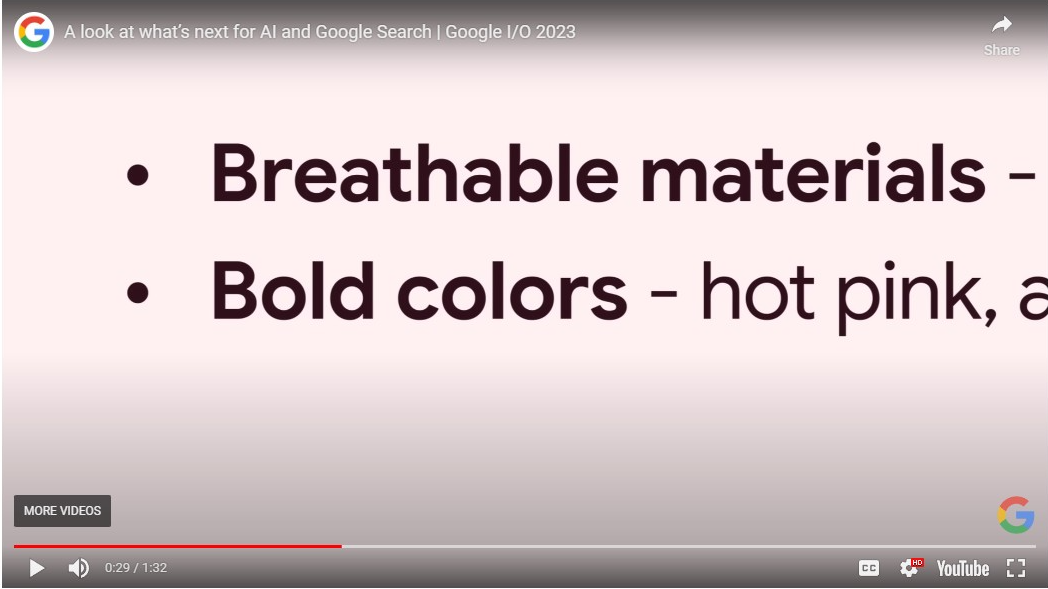
Cookie-cutter SEO and content strategies will not cut it anymore. Generative AI like ChatGPT has made it easier than ever to make content. But making content was never the goal, is your strategy ready to adapt to how Google is changing?
Let’s take a look.
A shift to off-page content
Traditionally, most SEO companies put a focus on on-page content like blog posts. I think this content will continue to be a strong part of your marketing strategy, but Google has shown a strong interest in making Google search the go-to source for everything about online research.
You can see this in the announcement of perspectives on Search.
Instead of hotels relying on 10 blue links as they do now, Google will push content from a variety of sources to help searchers understand a place before they travel. This means hotels and other hospitality companies will need to have a strong off-page content strategy to capture people as they look for information about a specific location.
Here are some observations about this and some thoughts on how your company can adapt to the perceived changes:
- Since Google is a for-profit company, they want to prioritize some sources while throttling how much they display other sources.
- I think YouTube shorts will be vital for thai aspect of perspective in search. You should start to think about how you will make short, snackable content to help your audience learn more about a destination than just on-site content.
- I suspect Google will throttle content from TikTok and Facebook. We have already seen Facebook and YouTube throttle how often TikTok content is shown. I would expect this trend to continue as Google wants to promote their content, publisher content, and even neutral content (like Reddit and other sources that are not direct competitors).
- Google has always had an interesting relationship with Pinterest. I recommend that your business builds out your Pinterest strategy if you sell clothing or rely on visual research.
You content strategy for off-page and on-page content will need to change as Google changes how it presents content in SERPs. Your on-page content will need to be dense with specific information about the topic, and catered to the needs of people in the process of search.
Off-page content will need to focus on specific platforms that Google will use to pull in content for perspective on Search. However, the type of content and platforms will likely vary by industry as I don’t suspect Google will show the same results for hotels as it will for B2B products.
I make this assumption because Google already shows different types of content by industry, and I expect that trend to continue.
A shift in local content
One of the main focuses that I noticed with Google’s promotion and features that have rolled out since then is that Google wants to make search interactive.
But even more, Google wants to make search local to help people find local results. This focus is to counteract TikTok’s growth and promote Google’s local ads (remember how Google wants to monetize search more?).
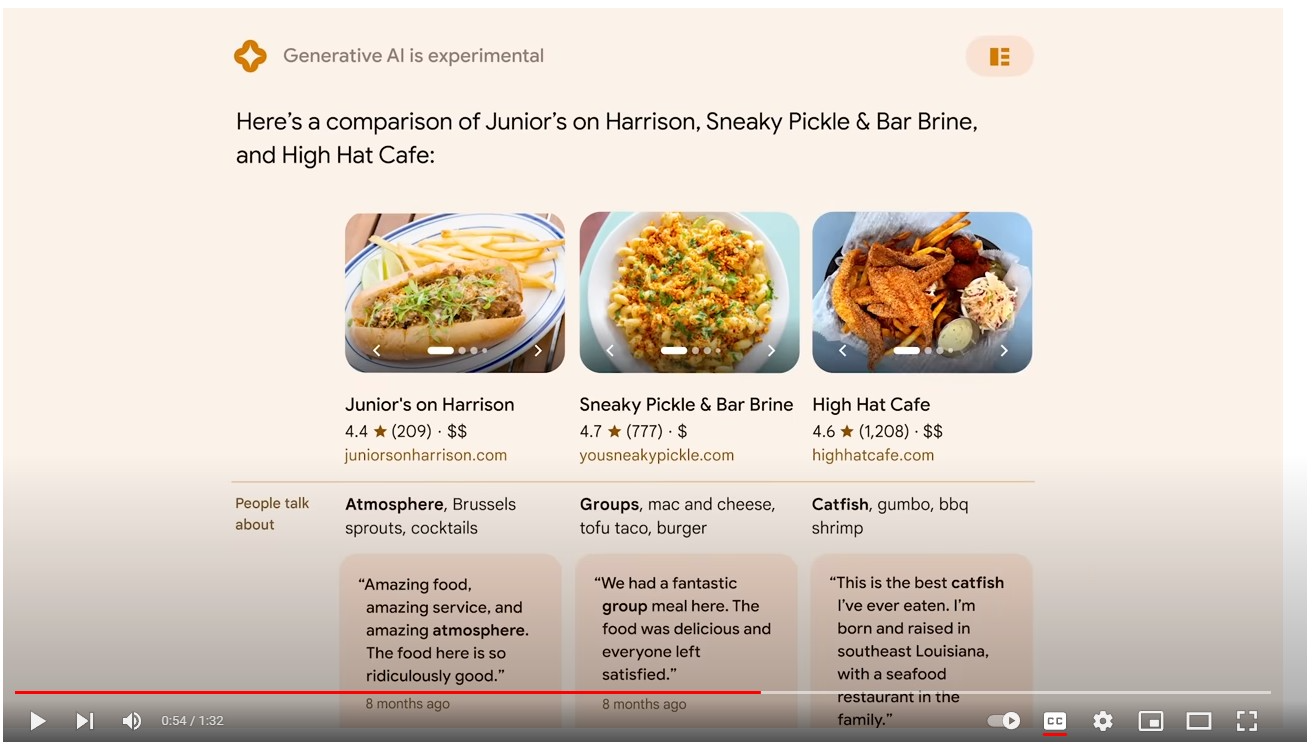
In the example above, we see how search results might look for local restaurants. I think it’s important to think about how this feature will play out in a larger setting. How will Google present restaurants for very specific long-tail search queries? How many restaurants will it show at a time?
I don’t know any of the answers, but what I can tell you is that Google will tweak it’s algorithms to show reviews, testimonials, and links to the GBP profile. If you offer products or services to a local customer base then you need to get your GBP listing optimized and focus on videos and images.
I mean that- you should start working on that right now. I mean, to be honest you should already have that content ready to publish already, but now is the time to prioritize that content because Google is going to swamp SERPs with local content for restaurants, hotels, attractions, and other types of local businesses.
A shift in paid ads
As discussed in prior sections, I fully expect Google to position paid Search Ads, Shopping Ads, and any other type of paid ad asset it has at the top of search results.
Think about it, Google wants to make the search experience more interactive, why not make it more profitable for them at the same time?
This means Google will place paid Search ads for any search query that has a commercial or transaction intent to it. Google will also find a way to weave in Google Shopping Ads for product searches. Google will also prioritize placement of Google Hotel Ads for hotel searches, Google Flight information for people looking for a flight, etc.
Google has been making many subsets of paid advertisement in the past few years, and now is the time Google will promote the heck out of those assets.
The end result? You will need to optimize Google Ads for a variety of intents, and have a firm handle on how you implement your strategy.
Your business will need to run paid advertising with Google, and your business will need to think through how you integrate those paid advertisements into your overall marketing strategy.
There is just no two ways around it. Your business will need to spend some money on Google, and you will need to make that advertising budget stretch even further with a PPC agency that understands the landscape and have a firm grasp on the overall strategy you need to succeed.
Want to learn how to adjust your PPC strategy for specific small businesses? Here are a few examples:
A few additional takeaways
I love to think about SEO. I love that you need to think through the customer journey, search intent, and other factors then align those findings with what I perceive is in Google’s best interest.
This is Google’s sandbox, and as a for-profit company they need to push their own content and keep their competitive advantage.
I think content farms are going away. This is the type of content production that you would see on Fiverr, because generative AI copywriting tools already produce as-good if not better content than B-level writers on Fiverr.
If you make your living on $5 posts, I think you are going to have a bad time.
I think affiliate marketing sites are going away. Everything from the large affiliate sites to the small players, Google is going to position content in a way that promotes their shopping ads and paid ads above organic listings.
This plays into Google’s best interest from a financial standpoint, because they don’t want to promote site that sell items without Google getting it’s “fair share.”
The future of search and your business
If you run a business then your success is tied directly to how Google and other search engines collect, aggregate, and show content.
Google has not changed, for the most part, in over 25 years. The traditional blue links dominate search results, but the future will change all of that.
Because it has to.
Generative AI writing tools have brought the barrier of entry for content way down. Now, don’t get me wrong, I think the answer is not just AI, because we still need creativity and customer input so human guidance is needed.
But from a business perspective, Google has to adapt because the entire landscape of content is changing which will impact how much content will be available.
It’s your obligation as a business owner to make sure your marketing strategy is future proofed, or at least ready for the change.
Is your marketing strategy ready for the change that is coming? If not, let’s talk.

